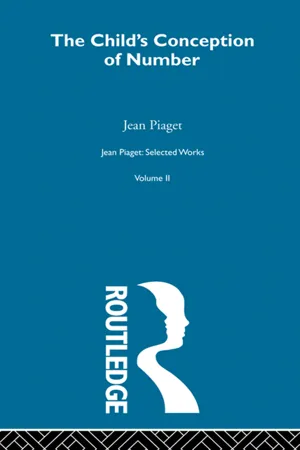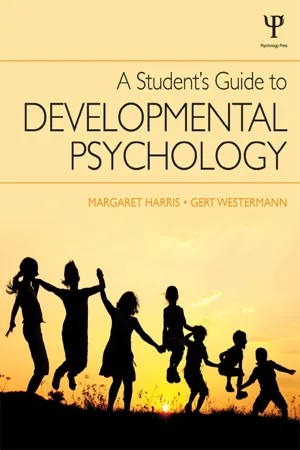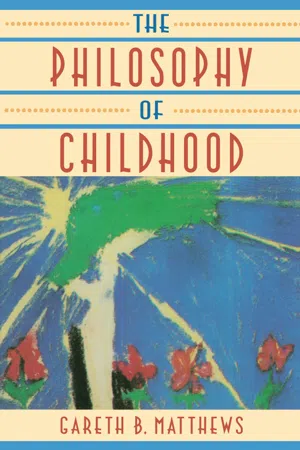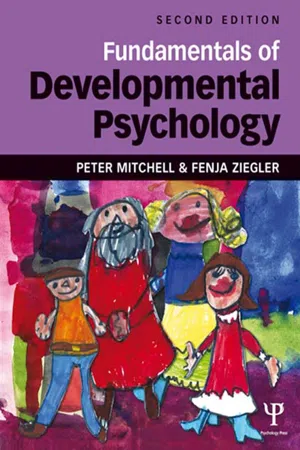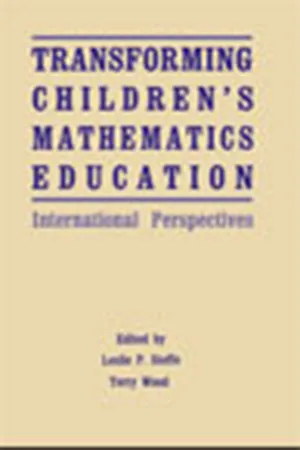Conservation of Number Piaget
Conservation of number, as described by Piaget, is a concept in developmental psychology that refers to a child's ability to understand that the quantity of a set of objects remains the same even when the arrangement or appearance is altered. This concept is a key component of Piaget's theory of cognitive development, highlighting the stages through which children develop an understanding of mathematical concepts.
8 Key excerpts on "Conservation of Number Piaget"
- eBook - ePub
Cognitive Development
An Information-Processing View
- David Klahr, J. G. Wallace(Authors)
- 2022(Publication Date)
- Routledge(Publisher)
...5 Conservation of Quantity The classic version of the Piagetian test for conservation of quantity starts with the presentation of two distinct collections of equal amounts of material (for example, two rows of beads, two vessels of liquid, or two lumps of clay). First the child is encouraged to establish their quantitative equality (for example, “Is there as much to drink in this one as in that one?” or “Is it fair to give this bunch to you and that bunch to me?”). Then he observes one of the collections undergo a transformation that changes some of its perceptual features while maintaining its quantity (for example, stretching, compressing, pouring into a vessel of different dimensions). Finally, the child is asked to judge the relative quantity of the two collections after the transformation. To be classified as “having conservation” the child must be able to assert the continuing quantitative equality of the two collections without resorting to a requantification and comparison after the transformation; that is, his response must be based not upon another direct observation, but rather upon recognition of the “logical necessity” for initially equal amounts to remain equal under “mere” perceptual transformations. The problem for students of cognitive development has been stated by Wallach (1969): Much as conservation is later taken entirely for granted, Piaget... and others... have shown clearly that until the age of six or seven children believe that quantities do change under such transformations. What happens at that point? How do these children come, like us, to consider it an absurdity even to ask whether amounts might change with different containers or arrangements? [p. 191] This chapter is organized as follows: first, we present a theory of concrete operational performance on tasks involving conservation of discontinuous quantities such as collections of beads...
- eBook - ePub
- Leslie Smith(Author)
- 2002(Publication Date)
- Routledge(Publisher)
...(1984) “Training effects on the development and generalization of Piagetian logical operations and knowledge of number”, Journal of Educational Psychology 76:766–776. Cowan, R. (1979) “Performance in number conservation tasks as a function of the number of items”, British Journal of Psychology 70:77–81. Elkind, D. (1967) “Piaget’s conservation problems”, Child Development 38:15–27. Gelman, R. (1972) “Logical capacity of very young children: Number invariance rules”, Child Development 43:75–90. Gelman, R. (1982) “Accessing one-to-one correspondence: Still another paper about conservation”, British Journal of Psychology 73:209–220. Gelman, R. and Gallistel, C.R. (1978) The child’s understanding of number, Cambridge, MA: Harvard University Press. Gold, R. (1978) “On the meaning of nonconservation”, in A.M.Lesgold, J.W. Pellegrino, S.D.Fokkema and R.Glaser (eds) Cognitive psychology and instruction, New York: Plenum. Halford, G.F. and Boyle, F.M. (1985) “Do young children understand conservation of number?” Child Development 56:165–176. Katz, H. and Beilin, H. (1976) “A test of Bryant’s claims concerning the young child’s understanding of quantitative invariance”, Child Development 47:877–880. Light, P.H. and Gilmour, A. (1983) “Conservation of conversation? Contextual facilitation of inappropriate conservation judgments”, Journal of Experimental Child Psychology 36:356–363. McGarrigle, J. and Donaldson, M. (1975) “Conservation accidents”, Cognition 3: 341– 350. Michie, S. (1984) “Why preschoolers are reluctant to count spontaneously”, British Journal of Developmental Psychology 2:347–358. Piaget, J. (1952) The child’s conception of number, New York: Norton. Rose, S.A. and Blank, M. (1974) “The potency of context in children’s cognition: An illustration through conservation”, Child Development 45:499–502. Russell, B. (1919) Introduction to mathematical philosophy, London: Allen & Unwin. Saxe, G.B...
- eBook - ePub
- Brian Butterworth(Author)
- 2018(Publication Date)
- Routledge(Publisher)
...To possess this concept, the necessary preconditions were a grasp of certain logical principles, since numbers are really a part of logic: Our hypothesis is that the construction of number goes hand-in-hand with the development of logic, and that a pre-numerical period corresponds to a pre-logical level. Our results do, in fact, show that number is organized, stage after stage, in close connection with gradual elaboration of systems of inclusion (hierarchy of logical classes) and systems of asymmetrical relations (qualitative seriations), the sequence of numbers thus resulting from an operational synthesis of classification and seriation. In our view, logical and arithmetical operations therefore constitute a single system that is psychologically natural, the second resulting from a generalization and fusion of the first, under two complementary headings of inclusion of classes and seriation of relations, quality being disregarded. (Piaget, 1952. viii) Thus, for Piaget, the “concept of number”, (which corresponds to our idea of “numerosity”), is built on more basic and more general capacities available initially in the concrete operational stage. These included the capacity to reason transitively; that is, the child should be able to reason from the facts that if A is bigger than B, and B is bigger than C, then A is bigger than C. Without this capacity, the child could not put the numbers in order of size, which is clearly fundamental. A second capacity the child must develop, is the idea that the number of things in a set is “conserved”, to use his technical term, unless a new object is added to the set, or an object subtracted from it. Merely moving the objects around – should not affect number: for example, spreading them out so they take up more room. Even more basic than either of these two capacities, as Piaget pointed out, is the ability to abstract away from the perceptual properties of the things in the set, and not be seduced by physical appearances...
- eBook - ePub
Child's Conception of Number
Selected Works vol 2
- Jean Piaget(Author)
- 2013(Publication Date)
- Routledge(Publisher)
...Conservation of Quantities and Invariance of Wholes Conservation of Continuous Quantities DOI: 10.4324/9781315006222-2 Every notion, whether it be scientific or merely a matter of common sense, presupposes a set of principles of conservation, either explicit or implicit. It is a matter of common knowledge that in the field of the empirical sciences the introduction of the principle of inertia (conservation of rectilinear and uniform motion) made possible the development of modern physics, and that the principle of conservation of matter made modern chemistry possible. It is unnecessary to stress the importance in every-day life of the principle of identity; any attempt by thought to build up a system of notions requires a certain permanence in their definitions. In the field of perception, the schema of the permanent object 1 presupposes the elaboration of what is no doubt the most primitive of all these principles of conservation. Obviously conservation, which is a necessary condition of all experience and all reasoning, by no means exhausts the representation of reality or the dynamism of the intellectual processes, but that is another matter. Our contention is merely that conservation is a necessary condition for all rational activity, and we are not concerned with whether it is sufficient to account for this activity or to explain the nature of reality. 1 La Construction du Réel chez l’Enfant, chapter i. This being so, arithmetical thought is no exception to the rule. A set or collection is only conceivable if it remains unchanged irrespective of the changes occurring in the relationship between the elements. For instance, the permutations of the elements in a given set do not change its value. A number is only intelligible if it remains identical with itself, whatever the distribution of the units of which it is composed...
- eBook - ePub
- Margaret Harris, Gert Westermann(Authors)
- 2014(Publication Date)
- Psychology Press(Publisher)
...The best-known example is probably conservation of volume, which involves judgements about the amount of water in three glasses, A, B and C. In Piaget’s original conservation task the experimenter begins by showing two glasses with equal amounts of water in them. Children will tell you that the amount of water is the same. Then, in full sight of the child, the water from one glass is poured into a third one that is narrower and taller, so that the water level is higher than before. Preschool children will now say that there is more water in the glass with the higher level. This is because they have failed to compensate a change in the height of the liquid by the change in the width that results from the water being poured into a differently shaped glass. Nor can children of this age understand the important principle of reversibility, that is, if the water is poured back into the original jar then the levels will once again be the same. Pre-operational children are said not to be able to imagine the sequence of changes in the appearance of the water in the successive jars that would accompany a reversal of the height of the liquid to its original level. The same lack of conservation is evident in other domains, including the case of conservation of number. In the classic conservation task, two rows of coins are first equally spaced so they have the same overall length and then one of them is spread out so that now the second row looks longer. Preschool children will now claim that the more spread out row contains more coins. Figure 8.1 shows some examples of Piagetian conservation problems. Figure 8.1 Examples of Piagetian conservation problems. Further evidence of pre-operational children’s inability to compare different views comes from Piaget’s studies of egocentrism. At its simplest, egocentrism can be defined as looking on the world only from one’s own perspective...
- eBook - ePub
- Gareth Matthews(Author)
- 1996(Publication Date)
- Harvard University Press(Publisher)
...4 Piaget and Conservation S o far, no doubt, I could be charged with being a romantic about childhood. Perhaps I am a romantic. I admit that I want to encourage in adults—especially in college students who take my philosophy courses, but also in adults quite generally—a style of “naive” questioning that comes naturally to many children, and comes hard, often very hard, to many adults. Piaget, one might think, is much more serious about childhood than I am. He realizes how important it is for children to grow up. He wants to help us all understand better some of the ways in which growing up, mentally, requires overcoming what one might call the “cognitive deficits” of childhood. To sharpen up what I want to say about Piaget let us turn, now, to some of those supposed deficits and to the gains that are supposed to wipe them out. In this chapter I shall argue that even the cognitive developments that Piaget charts most persuasively are not the straightforward achievements they might at first seem to be. Conservation experiments are perhaps the most famous experiments in the Piagetian repertory. They lie at the heart of his contribution to the study of childhood. They offer what he himself seems to have taken as crucial support for his claim that young children are what he calls “egocentric phenomenalists.” In this chapter I shall devote myself exclusively to what Piaget and his colleague Bärbel Inhelder say about the conservation of “substance,” weight, and volume in young children...
- eBook - ePub
- Peter Mitchell, Fenja Ziegler(Authors)
- 2013(Publication Date)
- Psychology Press(Publisher)
...The goal of counting is obvious to adults, we count to find out how many items are in a given set—the most important part is therefore the final, or cardinal, number as it represents the set size. It is questionable whether children view counting in the same way: they seem to engage in counting as a kind of game. Evidence for this suspicion is described by Dehaene (1997). He suggests that a 3-year-old who has just counted all her toys in a basket would not know the answer to the question of how many toys she had. This failure to understand the connection between the act of counting and its goal (how many?) points to a failure in understanding. A sense of counting only develops later, possibly through an interplay of the number sense (having an idea of the quantity without having to count) and observation that a given number applies to the particular quantity in question. Dehaene suggests that after a number of observations children begin to learn that counting relates to quantity in a meaningful way. Piaget Revisited Why do tests of children’s counting abilities show such different results? The idea that children do not understand counting, even though they are capable of the mechanisms of it, resonates perfectly with the Piagetian idea of number conservation, which we first encountered in chapter 3. In this experiment Piaget demonstrated that children do not understand the rules or the logic of counting, including one-to-one correspondence and cardinal number until they are 6 years old. Recall that Piaget presented children with a row of buttons that was spaced tightly together and a row of buttons that was of the same number but widely spaced so that it was longer in appearance. Children mistakenly report that this second line is longer than the first, ignoring the principles of counting...
- eBook - ePub
Transforming Children's Mathematics Education
International Perspectives
- Leslie P. Steffe, Terry Wood(Authors)
- 2013(Publication Date)
- Routledge(Publisher)
...Chapter 3.6 Young Children’s Concept of Measure Patricia F. Campbell University of Maryland, USA The conceptualization of number is an integral component of mathematical learning in early childhood. However, as noted by Vergnaud (1987), the concept of number can be interrelated with the concept of measure. Number in its most general form is quantity. What distinguishes number from sequencing, as in rote counting, is a unit of measure distinct from a lexical item. When a child assigns a number to a collection of discontinuous items via counting, the units that the child perceives are the individual items in the collection. For a set of discrete items, children learn to determine quantity by the number of unit entities, regardless of their size or relative position. Although young children may differ in terms of the type of unit they are capable of counting (Steflfe, von Glasersfeld, Richards, & Cobb, 1983), it has been proposed that in the discrete domain the processes of comparing and transforming, of incrementing and decrementing units, have a major influence on the development of numerical abstraction (Cooper, 1984; Sinclair, 1987b; Starkey & Gelman, 1982). But in addition to discrete counting, measuring may also serve as a precursor to early systems of reasoning (Sinclair, 1987b). Furthermore, the process of measuring can occur at differing conceptual levels. In the most general case of measurement, quantity is a function of both the number and size of the units; in addition, different units may be utilized when determining the measure of a fixed quantity. If the size of a unit of measure is changed, then the number of units associated with an invariant quantity is also changed. Davydov (1982) noted this when he characterized a quantity as not having “numerical determinacy” until a unit of measurement had been identified...



